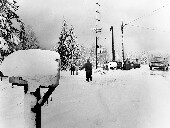
WEDNESDAY, Jan. 6 (HealthDay News) — Frigid temperatures can pose health risks, especially for young children, seniors and people with chronic illnesses, warns the U.S. Centers for Disease Control and Prevention.
The agency said people need to take steps to protect themselves from cold-related injuries and check to make sure their family, friends and neighbors are safe and warm during wintry weather periods.
Frostbite and hypothermia are two of the most common cold weather-related dangers. Frostbite causes skin to initially appear red and feel painful. Left untreated, skin will turn white or grayish and feel firm, waxy or numb. Hypothermia symptoms include shivering, exhaustion, confusion, fumbling hands, memory problems, drowsiness and slurred speech. People with symptoms of frostbite or hypothermia should seek immediate medical attention, the CDC advised.
When the temperature plummets, stay inside in homes and buildings that are properly heated. If your home isn’t heated, you should find other ways to keep warm:
- Wear winter clothing indoors, including layers of warm clothes, as well as socks, shoes and hats. Use blankets for additional warmth.
- Close off unused, exterior rooms and have people gather together in a single interior room.
- Seek shelter in heated public locations, such as malls, libraries and homeless shelters.
The CDC also offered tips for people who have to go outside in frigid weather:
- Wear proper outdoor clothing, including layers of light, warm clothing along with hats, scarves, mittens and waterproof boots.
- Be aware of the wind chill factor.
- Work slowly when doing outside chores.
- Take a friend and an emergency kit when doing outdoor recreational activities.
- Carry a cell phone.
- Don’t travel when the weather service has issued advisories. If you must travel, tell a friend or relative about your proposed route and expected time of arrival.
- Sprinkle cat litter on icy patches.
More information
The U.S. Federal Emergency Management Agency has more about winter storms and extreme cold.

